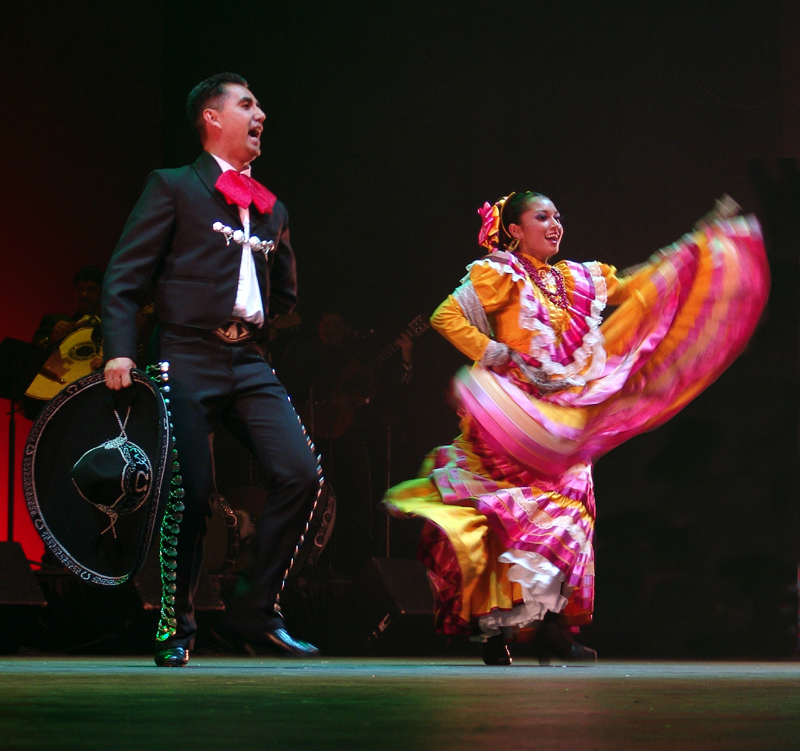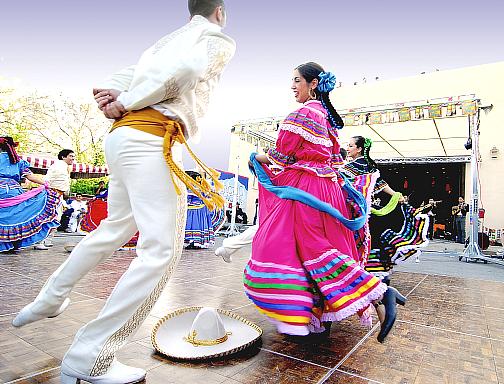
墨墨西哥帽子舞 Jarabe Tapartio
這是眾多旋律優美的墨西哥民謠中,最具代表性的歌曲。此曲旋律相當特殊,是由好幾段不同的曲調組成,但卻不相互衝突,反而因變化多端而迷人。本曲是墨西哥人跳傳統舞蹈必跳的舞,舞蹈內容男女舞者圍繞這墨西哥帽起舞及變化舞步,相當有趣。現今墨西哥帽子舞已被稱為墨西哥的國舞。 
The Mexican Hat Dance :
This courting dance became so popular that at one point it was declared "National Folk dance" of Mexico. This is due largely to Anna Pavlova, the great Russian Ballerina, who visited Mexico in 1919, fell in love with the culture and the spectacular costumes and decided to include the (heretofore) "Mexican Hat Dance" in her permanent repertoire. The ecstatic Mexican cultural authorities felt that such honor could only mean that the hat dance was indeed the most important dance in Mexico. So it was decreed that it had to be danced on pointe, and wearing the "China Poblana" Outfit.
However, the much celebrated "Hat Dance" is a composition born during the revolution (1910 -?) as a form of national unity. It includes the most commanding Mexican dance forms, in a medley known as Jarabe, roughly translated as "sweet syrup"; which by the way has all dance experts at each other's throat trying to define why it is called that. The word "Jarabe" is derived from the arabian word "Xarab" which means mixture of herbs. So is the dance called Jarabe because of the sweet courtship between the couples, or because of the association between the multiple mixed ingredients and the mixture of popular local songs?
El Jarabe Tapatío is composed of excerpts from:
- Jarabe de Jalisco - From the state of the same name
- Jarabe del Atole - A famous public domain jarabe from the late 1800's
- Son del Palomo - Perhaps Mexico's most common "son"
- a Jarana Yucateca - The typical dance style from the Peninsula of Yucatán
- Jarabe Moreliano - From the state of Michoacán
- La Diana - Mexico's musical applause number
It originally included singing and became widely spread all over Mexico up to around 1920 as a fashionable expression. Jarabes have been the dance and music symbols of most Central and southern Mexican states. Some of them have a complicated musical structure and involve the most popular regional tunes. The style was born from the local interpretation given to the "Sonecillos de mi tierra" a successful Spanish touring company that visited the largest cities of the country during and even after the colonial period (1521-1810 AD).
Costumes
The typical male and female costumes to dance it were used one hundred years apart from each other. The China Poblana was the female servant outfit of the early to mid 1800's. The charro suit decorated with silver buttons, came about with the emergence of the Mariachi around 1930 after going through numerous evolutions, from the hacienda supervisors to the modern urban musicians.
Mexican "Chinas"
Many legends have been attached to the China (Pronounced "CHEENA") outfit, including the romantic story about the oriental princess sold as a slave in the city of Puebla, who then fell in love with a Creole, and created her wedding gown based on the local fashions but decorated with oriental motifs.
The truth behind the costume is that every three months a ship carrying goods from the Philippines known as "Nao de China" (Ship from China), anchored in Acapulco. The aristocratic ladies purchased a textile known as "castor" to make skirts for their female servants, called "Chinita" or "china". The word is completely disassociated from any Oriental background. As the length of this fabric was not enough to reach the floor, an addition of silk was sewn at the top of the skirt to complete the length.
With time and dedication the women embroidered or applied sequins to highlight the oriental decoration of the fabric. The modern China Poblana's outfit is so saturated with sequins that the historic "castor" fabric (Which is only made in Puebla and Mexico city today) can only be seen if you turn the skirt inside out.
Costumes
The typical male and female costumes to dance it were used one hundred years apart from each other. The China Poblana was the female servant outfit of the early to mid 1800's. The charro suit decorated with silver buttons, came about with the emergence of the Mariachi around 1930 after going through numerous evolutions, from the hacienda supervisors to the modern urban musicians.
Mexican "Chinas"
Many legends have been attached to the China (Pronounced "CHEENA") outfit, including the romantic story about the oriental princess sold as a slave in the city of Puebla, who then fell in love with a Creole, and created her wedding gown based on the local fashions but decorated with oriental motifs.
The truth behind the costume is that every three months a ship carrying goods from the Philippines known as "Nao de China" (Ship from China), anchored in Acapulco. The aristocratic ladies purchased a textile known as "castor" to make skirts for their female servants, called "Chinita" or "china". The word is completely disassociated from any Oriental background. As the length of this fabric was not enough to reach the floor, an addition of silk was sewn at the top of the skirt to complete the length.
With time and dedication the women embroidered or applied sequins to highlight the oriental decoration of the fabric. The modern China Poblana's outfit is so saturated with sequins that the historic "castor" fabric (Which is only made in Puebla and Mexico city today) can only be seen if you turn the skirt inside out.
(http://www.mexfoldanco.org/jarabe.shtml)
請閱讀更多我的博客文章>>>
 選擇“Disable on www.wenxuecity.com”
選擇“Disable on www.wenxuecity.com”
 選擇“don't run on pages on this domain”
選擇“don't run on pages on this domain”

